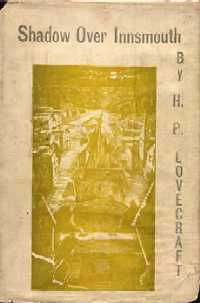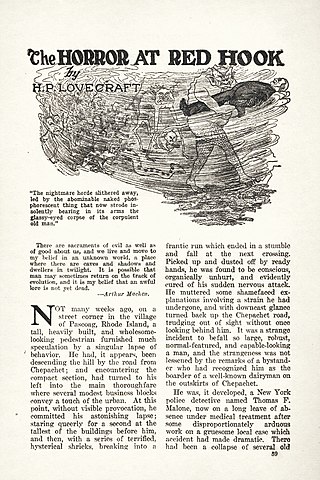
The Cthulhu Mythos is a mythopoeia and a shared fictional universe, originating in the works of American horror writer H. P. Lovecraft. The term was coined by August Derleth, a contemporary correspondent and protégé of Lovecraft, to identify the settings, tropes, and lore that were employed by Lovecraft and his literary successors. The name "Cthulhu" derives from the central creature in Lovecraft's seminal short story "The Call of Cthulhu", first published in the pulp magazine Weird Tales in 1928.

Cthulhu is a fictional cosmic entity created by writer H. P. Lovecraft. It was first introduced in his short story "The Call of Cthulhu", published by the American pulp magazine Weird Tales in 1928. Considered a Great Old One within the pantheon of Lovecraftian cosmic entities, this creature has since been featured in numerous popular culture references. Lovecraft depicts it as a gigantic entity worshipped by cultists, in the shape of a green octopus, dragon, and a caricature of human form. The Lovecraft-inspired universe, the Cthulhu Mythos, where it exists with its fellow entities, is named after it.

"The Call of Cthulhu" is a short story by American writer H. P. Lovecraft. Written in the summer of 1926, it was first published in the pulp magazine Weird Tales in February 1928.

Henry Kuttner was an American author of science fiction, fantasy and horror.

The Shadow over Innsmouth is a horror novella by American author H. P. Lovecraft, written in November–December 1931. It forms part of the Cthulhu Mythos, using its motif of a malign undersea civilization, and references several shared elements of the Mythos, including place-names, mythical creatures, and invocations. The Shadow over Innsmouth is the only Lovecraft story that was published in book form during his lifetime.
The Hyperborean cycle is a series of short stories by Clark Ashton Smith that take place in the fictional prehistoric setting of Hyperborea. Smith's cycle takes cues from his friends, H. P. Lovecraft and Robert E. Howard and their works. Lovecraft wrote to Smith in a letter dated 3 December 1929: "I must not delay in expressing my well-nigh delirious delight at The Tale of Satampra Zeiros [Smith's short story]... [W]hat an atmosphere! I can see & feel & smell the jungle around immemorial Commoriom, which I am sure must lie buried today in glacial ice near Olathoe, in the Land of Lomar!". Soon afterward, Lovecraft included Smith's Tsathoggua in the story "The Mound", ghostwritten for Zealia Bishop in December 1929. Lovecraft also mentioned Tsathoggua in "The Whisperer in Darkness", which he began on February 24, 1930, and in "At the Mountains of Madness" a year later, along with the Hyperborean cities of Commoriom and Uzuldaroum. Because Smith in turn borrowed numerous Lovecraftian elements, the cycle itself may be regarded as a branch of the Cthulhu Mythos. In a letter to August Derleth dated 26 July 1944, Smith wrote: "In common with other weird tales writers, I have ... made a few passing references to some of the Lovecraftian deities. My Hyperborean tales, it seems to me, with their primordial, prehuman and sometimes premundane background and figures, are the closest to the Cthulhu Mythos, but most of them are written in a vein of grotesque humor that differentiates them vastly. However, such a tale as "The Coming of the White Worm" might be regarded as a direct contribution to the Mythos.".

"The Haunter of the Dark" is a horror short story by American author H. P. Lovecraft, written between 5–9 November 1935 and published in the December 1936 edition of Weird Tales. It was the last written of the author's known works, and is part of the Cthulhu Mythos. The epigraph to the story is the second stanza of Lovecraft's 1917 poem "Nemesis".

Lovecraftian horror, sometimes used interchangeably with "cosmic horror", is a subgenre of horror fiction and weird fiction that emphasizes the horror of the unknowable and incomprehensible more than gore or other elements of shock. It is named after American author H. P. Lovecraft (1890–1937). His work emphasizes themes of cosmic dread, forbidden and dangerous knowledge, madness, non-human influences on humanity, religion and superstition, fate and inevitability, and the risks associated with scientific discoveries, which are now associated with Lovecraftian horror as a subgenre. The cosmic themes of Lovecraftian horror can also be found in other media, notably horror films, horror games, and comics.
The Xothic legend cycle is a series of short stories by American writer Lin Carter that are based on the Cthulhu Mythos of H. P. Lovecraft, primarily on Lovecraft's stories "The Call of Cthulhu" and "Out of the Aeons".

The Whisperer in Darkness is a 26,000-word novella by American writer H. P. Lovecraft. Written February–September 1930, it was first published in Weird Tales, August 1931. Similar to The Colour Out of Space (1927), it is a blend of horror and science fiction. Although it makes numerous references to the Cthulhu Mythos, the story is not a central part of the mythos, but reflects a shift in Lovecraft's writing at this time towards science fiction. The story also introduces the Mi-Go, an extraterrestrial race of fungoid creatures.

"The Horror at Red Hook" is a short story by American writer H. P. Lovecraft, written on August 1–2, 1925. "Red Hook" is a transitional tale, situated between the author's earlier work and the later Cthulhu Mythos. Although the story depicts a sinister cult, this cult offers a conventionally occult devil-worshipping threat, rather than the cosmic threat depicted in his later work. Living in poverty in the slum of Red Hook at the time of writing, Lovecraft was at this time urgently attempting to widen his markets in the pulp magazines. By having an unusually proactive Irish New York police detective as his protagonist, he hoped for a swift sale to a detective pulp, which would have opened up a new market other than his usual Weird Tales magazine. He did not get such a sale, and had to fall back on Weird Tales. "Red Hook" was thus first published in the January 1927 issue of Weird Tales.
A Cthulhu Mythos anthology is a type of short story collection that contains stories written in, or related to, the Cthulhu Mythos genre of horror fiction launched by H. P. Lovecraft. Such anthologies have helped to define and popularize the genre.
Christopher Sequeira is a Sydney-based Australian editor, writer and artist who works predominantly in the speculative fiction and mystery realms. His published work includes poetry, prose, and comic-book scripts. Sequeira's creator-owned work includes "Sherlock Holmes: Dark Detective", Pulse of Darkness, Rattlebone: The Pulp-Faced Detective and The Borderlander.

Move Under Ground is a horror novel mashup by American writer Nick Mamatas, which combines the Beat style of Jack Kerouac with the cosmic horror of H. P. Lovecraft's Cthulhu Mythos. It is available as a free download via a Creative Commons license, CC BY-NC-ND 2.5 according to the License information in the CC version of the book.

This article provides a list of cultural references to the work of author H. P. Lovecraft. These references are collectively known as the Cthulhu Mythos. For works that are stylistically Lovecraftian, including comics and film adaptations influenced by Lovecraft, see Lovecraftian horror.
American author H. P. Lovecraft (1890–1937) created a number of fictional deities throughout the course of his literary career. These entities are usually depicted as immensely powerful and utterly indifferent to humans who can barely begin to comprehend them, though some entities are worshipped by humans. These deities include the "Great Old Ones" and extraterrestrials, such as the "Elder Things", with sporadic references to other miscellaneous deities. The "Elder Gods" are a later creation of other prolific writers who expanded on Lovecraft's concepts, such as August Derleth, who was credited with formalizing the Cthulhu Mythos. Most of these deities were Lovecraft's original creations, but he also adapted words or concepts from earlier writers such as Ambrose Bierce, and later writers in turn used Lovecraft's concepts and expanded his fictional universe.

Call of Cthulhu: The Wasted Land is a Lovecraftian horror tactical role-playing game developed by British studio Red Wasp Design in conjunction with Chaosium. The game was released in 2012, for iOS in January, for PC in May, and for Android in June.









